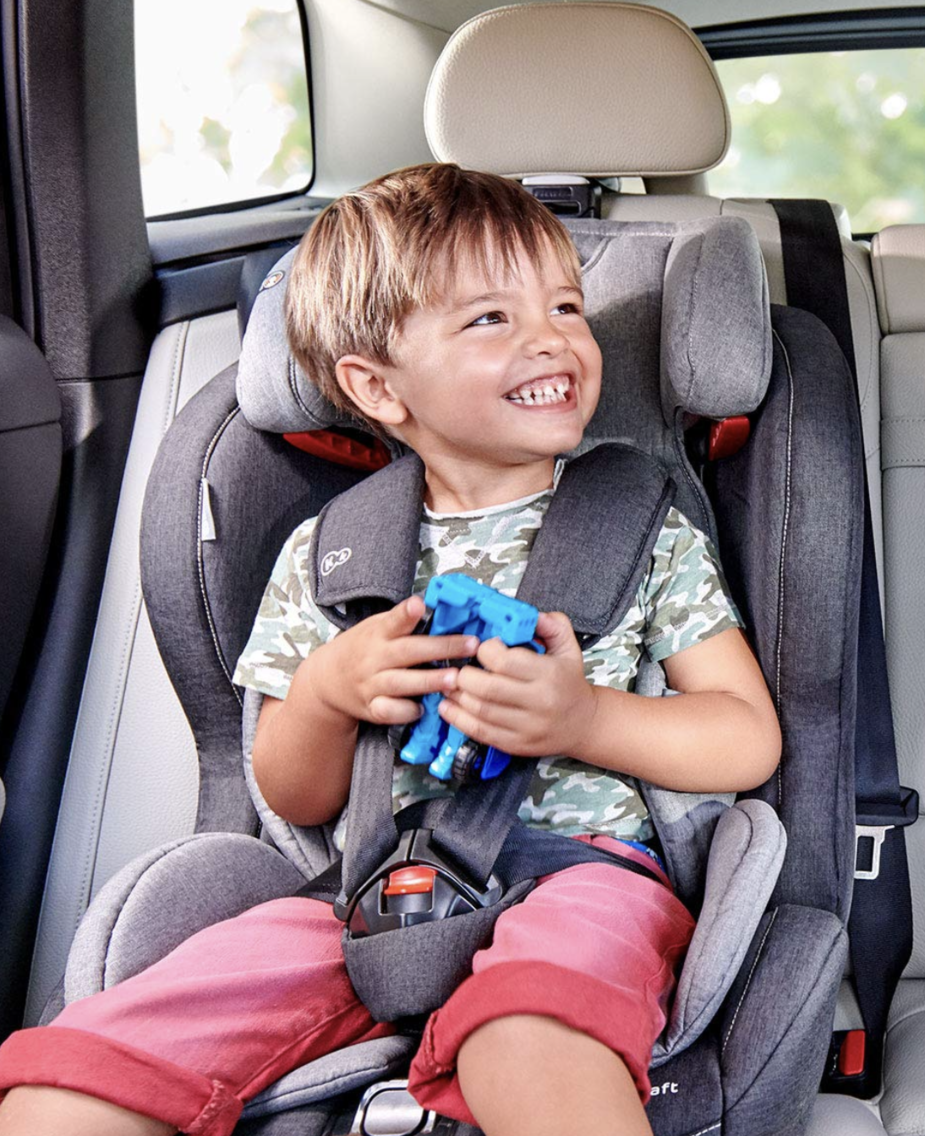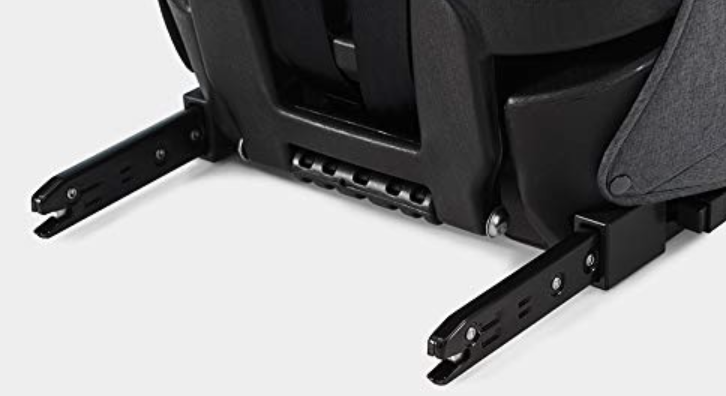CRD
In a world where we are crazy about child safety I do not understand those things. It prevents the baby from flying all over the cabin but when you watch crash tests already regular car occupants move an amazing amount forward until the belts actually hold them. I can only assume the baby will move forward much more and smash against the front seat. Then to make things worse the adults often only have lap belts so will likely “fold” forward in an accident more or less crushing the baby.
The only real argument could be that airplane accidents are judged to be so rare that the belt is actually meant to avoid people from flying all over the place in turbulence. In case of an actual accident all bets are off anyway. After all we do not give the adults 3 point belts in airliners, the seat row attachments are flimsy, usually no passenger airbags etc.
Regarding child safety and airplanes my personal rule is: if you would not do it in a car do not do it in an airplane, no matter what the regulations might allow.
if you would not do it in a car do not do it in an airplane, no matter what the regulations might allow
Glad my uncle never had a pilot licence  he used to drive Renault 309 with 9 people inside…
he used to drive Renault 309 with 9 people inside…
Steve6443 wrote:
This legislation, if no longer valid, should be removed from the statute books but it’s still there….other legislation which has been superseded is routinely removed with a note explaining when and through which new legislation it was replaced but it’s still appearing if you search for it…..
It could still be valid for D-reg Annex I aircraft, but not for EASA aircraft. E.g. some years ago, Swedish authorities updated most of the remaining national regulations to say that they did not apply to EASA aircraft (well, not in those words but with that effect.)
Steve6443 wrote:
Noting also that the German AIP Gen 1.6 refers specifically to LuftBO as the relevant national laws governing aircraft operation and if there is an exception there as noted above, which of these laws has priority if indeed 2019/1384 is to be complied with?
Your example shows the defunct process of an EU member state updating invalid law.
We’ve had it before and I’ll say it again: The AIP is not law. It’s information toilet paper that can coincide with law. Be vary of anything in the AIP, as you might happily fly around with two kids under the age of 10 sharing a seat, and if they get hurt, the famous german proverb “Unwissenheit schützt nicht vor Strafe” (ignorance does not protect against punishment) will be applied in court. It sucks, it’s crazy, it’s not your fault that outdated/invalid law remains published, but please still don’t shoot the messenger (me) ;) .
EU regulations take precedence over national law the moment they are in force, EU wide!
https://european-union.europa.eu/institutions-law-budget/law/types-legislation_en
Primacy of EU law (precedence, supremacy)
The principle of the primacy (also referred to as ‘precedence’ or ‘supremacy’) of European Union (EU) law is based on the idea that where a conflict arises between an aspect of EU law and an aspect of law in an EU Member State (national law), EU law will prevail. If this were not the case, Member States could simply allow their national laws to take precedence over primary or secondary EU legislation, and the pursuit of EU policies would become unworkable.
The principle of the primacy of EU law has developed over time by means of the case law (jurisprudence) of the Court of Justice of the European Union. It is not enshrined in the EU treaties, although there is a brief declaration annexed to the Treaty of Lisbon in regard to it.
In Van Gend en Loos v Nederlandse Administratie der Belastingen (Case 26/62), the Court declared that the laws adopted by EU institutions were capable of creating legal rights which could be enforced by both natural and legal persons before the courts of the Member States. EU law therefore has direct effect.
In Costa v ENEL (Case 6/64), the Court further built on the principle of direct effect and captured the idea that the aims of the treaties would be undermined if EU law could be made subordinate to national law. As the Member States transferred certain powers to the EU, they limited their sovereign rights, and thus in order for EU norms to be effective they must take precedence over any provision of national law, including constitutions.
Further examples of cases in which the Court affirmed the primacy of EU law include:
Internationale Handelsgesellschaft mbH v Einfuhr- und Vorratsstelle fur Getreide und Futtermittel (Case 11/70);
Amministrazione delle Finanze dello Stato v Simmenthal SpA (Case 106/77);
Marleasing SA v La Comercial Internacional de Alimentacion SA (Case C-106/89).
In these cases, the Court clarified that the primacy of EU law must be applied to all national acts, whether they were adopted before or after the EU act in question. Where EU law takes precedence over conflicting national law, the national provisions are not automatically annulled or invalidated. However, national authorities and courts must refuse to apply those provisions as long as the overriding EU norms are in force.
The principle of primacy therefore seeks to ensure that people are uniformly protected by an EU law across all EU territories.
It should be noted that the primacy of EU law only applies where Member States have ceded sovereignty to the EU – in fields such as the single market, environment, transport, etc. However, it does not apply in areas such as education, culture or tourism.*
https://eur-lex.europa.eu/EN/legal-content/glossary/primacy-of-eu-law-precedence-supremacy.html
*Snoopy remark: It’s roughly 70/30. 70% of the stuff is decided by the politicians voted for that sit in Brussels, and 30% is still decided by politicians acting nationally. Not an exact number, just a rough baseline.
Sebastian_G wrote:
The only real argument could be that airplane accidents are judged to be so rare that the belt is actually meant to avoid people from flying all over the place in turbulence. In case of an actual accident all bets are off anyway. After all we do not give the adults 3 point belts in airliners, the seat row attachments are flimsy, usually no passenger airbags etc. Regarding child safety and airplanes my personal rule is: if you would not do it in a car do not do it in an airplane, no matter what the regulations might allow.
Good post! I’d say it’s a case of “if the airlines do it, let GA do it”.
the seat row attachments are flimsy
They are probably stronger (16g+buffer) than a PA28 Wing Spar attachment bolt. Did you see the Asiana 777 crash in SFO?
For my kids I got this seat


It has ISOFIX and/or can be attached using a standard seatbelt and it has a separate 5 point harness included. The kids aren’t going anywhere.
For peculiar airplane use, bring some of these ratchet straps
to mount the seat extra secure!
Whenever possible, have your kids face opposite the direction of travel (ie rear mounted seats), it’s the biggest safety increase. In case all seats are forward looking in your vehicle/airplane, consider a reboarder such as the https://axkid.com Minikid series. I have one for sale for 99€ ;)
Snoopy wrote:
However, it does not apply in areas such as education, culture or tourism.
I guess the EU doesn’t issue regulations in these areas? Then the issue is moot.
Thinking about how child car seats work:
Obviously they are extensively tested for automotive use, but how much applies to aviation?
Commercially, I’ve never seen any children on an airliner in a car seat, so I would guess none of the above applies, except maybe 6 (pass the risk to the airline). It must be safer, but I can’t find any kind of study or statistics. Maybe in accident reports of large crashes?
For GA, side impact (4) is less of an issue as almost all crash forces will come from the front or bottom first. The wings are in the way too  Car-type accidents don’t really happen in planes. Aircraft taxi speeds are so low even a head-on collision between two planes would be ok without any seatbelt. Anything in cruise wouldn’t be survivable so the seat is irrelevant. It’s just takeoff and more importantly landing that it would make a difference, whether on airport or off. 1, 2 & 3 are more for comfort and convenience for turbulence or a hard landing.
Car-type accidents don’t really happen in planes. Aircraft taxi speeds are so low even a head-on collision between two planes would be ok without any seatbelt. Anything in cruise wouldn’t be survivable so the seat is irrelevant. It’s just takeoff and more importantly landing that it would make a difference, whether on airport or off. 1, 2 & 3 are more for comfort and convenience for turbulence or a hard landing.
Of course, the seats aren’t particularly heavy, but are bulky and difficult to move around. Our first baby seat was difficult to get into the cockpit and the seatbelt only just went around it. Another downside is that they can be fiddly and it can take a while to remove e.g. the undo main seatbelt then disengage the childproof restraints and wiggle the arms out.
For Jujupilote I would say a baby seat for a baby as you don’t really have a choice (check it fits), then a booster seat with or without back for later.
Thanks for the analysis, I doubt there is much data on crash testing of SEP vs SUV for adults? let alone babies in car seats?
AFAIK, only Diamonds have documented seat crash testing that went beyond CS23, they test their aircraft for high loads…of course, any human inside will be dead anyway at those limits without airbags everywhere?
I think what one misses with these “safety debates” is that using same baby & kid SUV car seats in SEP is healthy for their comfort: the pax are used to it in SUV and they fall into that routine trap in SEP: they sleep for 3h while flying (like while driving), they like that car seat as it has their smell with traces of their food and pee…
I also suggest anyone to get them used to wear headsets while at home or while driving the car, so that in aircraft it won’t be a “new thing” 
Ibra wrote:
Thanks for the analysis, I doubt there is much data on crash testing of SEP vs SUV for adults? let alone babies in car seats?
There is and is is part of the FAA certification documentation of child restraint systems for aircraft.